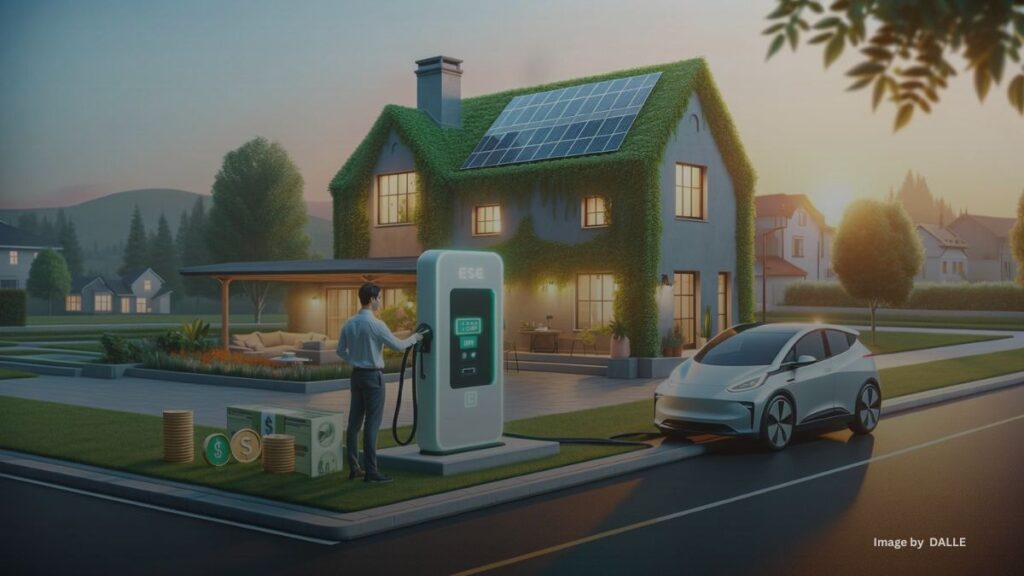Electric vehicles (EVs) are becoming more popular in Canada, thanks to their environmental benefits, lower operating costs, and improved performance. However, one of the main challenges for EV owners is finding a convenient and reliable place to charge their vehicles. While public charging stations are available across the country, they may not always be accessible, affordable, or fast enough for your needs. That’s why installing a charger at your home or at your building can be a smart and practical solution.
Key Takeaway Box
- Installing an EV charger at your home or at your building can provide you with convenience, reliability, and savings on your EV charging needs.
- You should choose the right type of charger for your needs, based on your EV model and battery size, your electrical capacity and wiring, and your budget and preferences.
- You should apply for the provincial and federal rebates and incentives that are available for EV charging infrastructure, which could save you up to 75% of the cost of buying and installing an EV charger.
- You should hire a qualified electrician to install your charger, following the local codes and standards and the manufacturer’s instructions and specifications.

But how do you go about installing an EV charger? What are the different types of chargers and how do they work? How much does it cost and how long does it take? And most importantly, how can you take advantage of the provincial and federal rebates and incentives that are available for EV charging infrastructure?
In this article, we will answer these questions and provide you with a step-by-step guide on how to install an EV charger at your home or at your building with provincial rebates. We will also explore the different programs and benefits offered by each province, how to apply for them, and how much you can save on your charger installation.
Step 1: Choose the right charger for your Electric Vehicle
The first step to installing an EV charger is to choose the right type of charger for your needs. There are three levels of EV chargers, each with different power output, charging speed, and installation requirements.
- Level 1 chargers are the simplest and cheapest option. They plug into a standard 120-volt household outlet and can deliver up to 1.4 kilowatts (kW) of power. They are suitable for plug-in hybrid electric vehicles (PHEVs) or EVs with small batteries that do not require frequent or fast charging. However, they are also the slowest option, taking up to 10 hours or more to fully charge an EV battery.
- Level 2 chargers are the most common and recommended option for home or building installation. They require a dedicated 240-volt circuit and can deliver up to 19.2 kW of power. They can charge an EV battery in 4 to 5 hours, depending on the battery size and the charger output. They are compatible with all EV models and offer a balance between cost, speed, and convenience.
- Level 3 chargers, also known as DC fast chargers, are the fastest and most expensive option. They require a high-voltage (480-volt) and high-current (up to 400-amp) connection and can deliver up to 350 kW of power. They can charge an EV battery in 30 to 60 minutes, depending on the battery size and the charger output. They are mainly found in public locations, such as highway rest stops, and are not recommended for home or building installation due to their high cost, energy demand, and potential impact on battery life.
To choose the right charger for your needs, you should consider the following factors:
- Your EV model and battery size. Different EVs have different battery capacities and charging capabilities. You should check your EV manual or manufacturer’s website to find out the maximum power input and charging speed of your vehicle. You should also consider the range and frequency of your driving habits and how often you need to charge your vehicle.
- Your electrical capacity and wiring. Different chargers have different electrical requirements and installation costs. You should consult a licensed electrician to assess your home or building’s electrical capacity and wiring, and to determine the best location and configuration for your charger. You should also check your local codes and regulations for any permits or inspections required for installing an EV charger.
- Your budget and preferences. Different chargers have different prices and features. You should compare the upfront and ongoing costs of buying and installing a charger, as well as the potential savings from reduced fuel and maintenance expenses. You should also consider the convenience and reliability of the charger, as well as any additional features, such as Wi-Fi connectivity, smart scheduling, or remote monitoring and control.
Step 2: Apply for provincial and federal rebates and incentives
The second step to installing an EV charger is to apply for the provincial and federal rebates and incentives that are available for EV charging infrastructure. These programs are designed to encourage and support the adoption of EVs and to reduce the greenhouse gas emissions from the transportation sector. Depending on your province and your eligibility, you could save up to 75% of the cost of buying and installing an EV charger.
Here is a summary of the provincial and federal rebates and incentives for EV charging infrastructure, as of February 2024:
- British Columbia: The province offers up to $350 for the purchase and installation of a Level 2 charger at a single-family home, and up to $2,000 for the purchase and installation of a Level 2 charger at a multi-unit residential building or a workplace. The federal government also offers up to $5,000 for the purchase and installation of a Level 2 charger at a multi-unit residential building or a workplace. To apply, visit the CleanBC website and the Natural Resources Canada website.
- New Brunswick: The province offers up to $750 for the purchase and installation of a Level 2 charger at a single-family home, and up to $5,000 for the purchase and installation of a Level 2 charger at a multi-unit residential building or a workplace. The federal government also offers up to $5,000 for the purchase and installation of a Level 2 charger at a multi-unit residential building or a workplace. To apply, visit the NB Power website and the Natural Resources Canada website.
- Nova Scotia: The province offers up to $500 for the purchase and installation of a Level 2 charger at a single-family home, and up to $5,000 for the purchase and installation of a Level 2 charger at a multi-unit residential building or a workplace. The federal government also offers up to $5,000 for the purchase and installation of a Level 2 charger at a multi-unit residential building or a workplace. To apply, visit the Efficiency Nova Scotia website and the Natural Resources Canada website.
- Newfoundland and Labrador: The province offers up to $500 for the purchase and installation of a Level 2 charger at a single-family home, and up to $5,000 for the purchase and installation of a Level 2 charger at a multi-unit residential building or a workplace. The federal government also offers up to $5,000 for the purchase and installation of a Level 2 charger at a multi-unit residential building or a workplace. To apply, visit the takeCHARGE website and the Natural Resources Canada website.
- Prince Edward Island: The province offers up to $500 for the purchase and installation of a Level 2 charger at a single-family home, and up to $2,500 for the purchase and installation of a Level 2 charger at a multi-unit residential building or a workplace. The federal government also offers up to $5,000 for the purchase and installation of a Level 2 charger at a multi-unit residential building or a workplace. To apply, visit the Efficiency PEI website and the Natural Resources Canada website.
- Quebec: The province offers up to $600 for the purchase and installation of a Level 2 charger at a single-family home, and up to $5,000 for the purchase and installation of a Level 2 charger at a multi-unit residential building or a workplace. The federal government also offers up to $5,000 for the purchase and installation of a Level 2 charger at a multi-unit residential building or a workplace. To apply, visit the Transition énergétique Québec website and the Natural Resources Canada website.
- Yukon: The territory offers up to $500 for the purchase and installation of a Level 2 charger at a single-family home, and up to $4,000 for the purchase and installation of a Level 2 charger at a multi-unit residential building or a workplace. The federal government also offers up to $5,000 for the purchase and installation of a Level 2 charger at a multi-unit residential building or a workplace. To apply, visit the Energy Branch website and the Natural Resources Canada website.
IMPORTANT LINKS
- How to Trade in Your Old Gas-Powered Vehicle for an Electric Vehicle with the BC Scrap-It Program
- How to Get a Tax Write-Off for Your Business with the Federal Tax Incentive for Electric Vehicles
- How to Save Money with the Federal iZEV Program for Electric Vehicles
- How to Find the Best Electric Vehicle Charging or Hydrogen Refuelling Station Near You
- How to Buy or Lease a Heavy-Duty Electric Vehicle with the Federal iMHZEV Program
Step 3: Hire a qualified electrician and install the charger
The third and final step to installing an EV charger is to hire a qualified electrician and install the charger. You should not attempt to install the charger yourself unless you are a licensed electrician, as this could pose serious safety risks and void your warranty. You should also make sure that the electrician you hire is familiar with the EV charger model you have chosen and the provincial and federal codes and standards for EV charging infrastructure.
To find a qualified electrician, you can use online platforms, such as Qmerit, HomeAdvisor, or Angie’s List, that connect you with certified and vetted professionals in your area. You can also ask for referrals from your friends, family, or neighbours who have installed an EV charger before. You should compare the quotes, reviews, and credentials of different electricians and choose the one that best suits your needs and budget.
The installation process may vary depending on the type of charger, the location of the charger, and the electrical capacity and wiring of your home or building. However, the general steps are as follows:
- The electrician will inspect your electrical panel and determine the best location and configuration for your charger. They will also check if you need any permits or inspections from your local authority.
- The electrician will install a dedicated circuit and outlet for your charger, or hardwire the charger directly to the electrical panel. They will also install a breaker, a conduit, and a disconnect switch if needed.
- The electrician will mount the charger on the wall or on a pedestal, following the manufacturer’s instructions and specifications. They will also connect the charger to the power source and test its functionality and safety.
- The electrician will clean up the work area and provide you with the invoice, warranty, and user manual for your charger. They will also explain to you how to use and maintain your charger and how to claim your rebates and incentives.
Conclusion
Installing an EV charger at your home or at your building is a worthwhile investment that can enhance your EV ownership experience and contribute to a greener future. By following the steps outlined in this article, you can install an EV charger with provincial rebates and enjoy the benefits of having your own EV charging station. If you have any questions or need any assistance, feel free to contact us at HustleHub, your trusted source for all things EV. We are here to help you make the most of your EV journey. Happy charging, Hustlers! 🚗
Source: (1) What to Expect When You Have an EV Charger Installed in Your Home. https://www.pcmag.com/how-to/ev-charger-installation-ride-along-step-by-step-instructions-for-your-home. (2) How to Charge an Electric Car at Home | Edmunds. https://www.edmunds.com/electric-car/articles/how-to-charge-an-electric-car-at-home.html. (3) Preparing for EV Charger Installation at Home | Edmunds. https://www.edmunds.com/electric-car/articles/ev-charger-installation.html. (4) Installing a Hardwired Home EV Charger – Legrand US. https://www.legrand.us/ideas/blogs/install-hardwired-home-ev. (5) Everything You Need to Know About Charging an EV at Home – MotorTrend. https://www.motortrend.com/features/home-ev-charging-installation-guide/.




